Galapagos Spirit
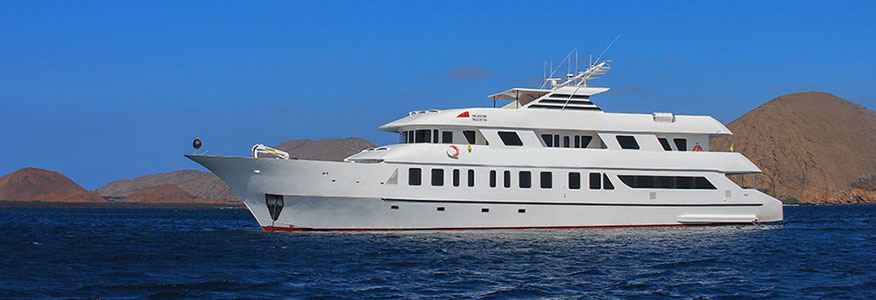


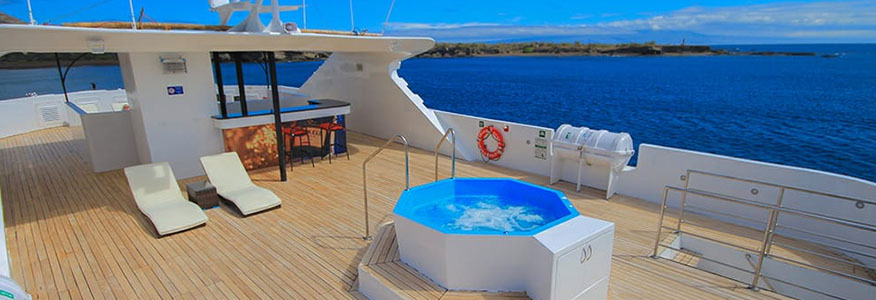

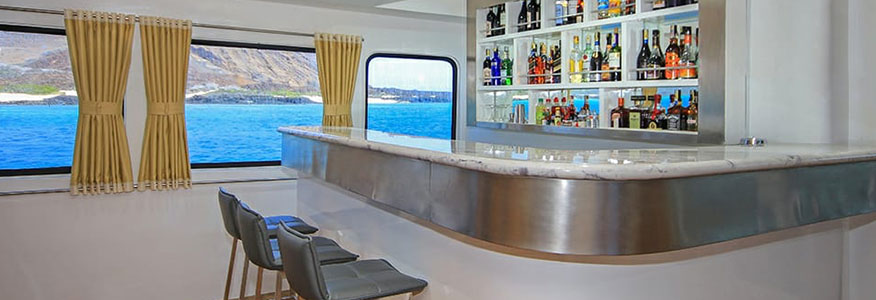
Galapagos Spirit
Named after the spirit of a nature lover that the Galapagos islands awake in each visitor that lives a Darwinian experience and admires this unique wildlife in the world, GALAPAGOS SPIRIT combines luxury and comfort while exploring this human heritage site. With capacity for 16 passengers, SPIRIT has four suites in the upper deck and five stateroom cabins in the main deck.
The Galapagos Spirit Luxury Yacht, is a 16-passenger galapagos motor yacht built in 2018 with the newest technology. It offers nine air-conditioned cabins all boast ocean views to enjoy of the wonderful landscape and private bathrooms to rest with privacy and confort. There are four spacious luxury cabins and private balconies. Travelers can enjoy jacuzzi, dining room and bar at any time of the trip.
DAY 1, SUNDAY, DECEMBER 25th
FLY TO GALAPAGOS & BOARD THE M/Y GALAPAGOS SPIRIT
Transfer to the airport in time for your flight to Galapagos which is typically in the morning and arrives to Galapagos before noon. Transfer to the luxury yacht M/Y GALAPAGOS SPIRIT
Begin your 3-night cruise through Darwin’s “Enchanted Islands”. Accommodation will be in eight cabins; 4 cabins on the main deck (2 queen size bed cabins and 2 twin bed cabins) and 4 cabins in the upper deck (2 queen size bed cabins and 2 twin bed cabins with private balcony). All cabins are spacious and feature a bath/shower and air-conditioning. All meals, snacks lectures and shore excursions are included.
The excursions and cultural programs are led by category “3” Naturalist Guide with years of experience in guiding in the Galapagos Islands and who stands out among the best Naturalist Guides in the whole archipelagos
PM: Interprettion Center & Tijeretas Hill
The Interpretation Center is an excellent place to learn about Natural History in the Galapagos and to learn about the San Cristobal History too. The Museum of Natural History displays information on the volcanic origins of the islands, their remoteness from the continent, ocean currents, climate, the arrival of the different species and their colonization, among other points of interest. Human history is also showcased, chronologically narrated by the most significant events related to the discovery and colonization of the islands.
Tijeretas Hill: It is called Tijeretas because this is the name commonly known for the frigate’s birds, it involves a high-intensity walk amidst beautiful landscapes. (L, D)
DAY 2, MONDAY, DECEMBER 26th
AM: BARTOLOME ISLAND
This is for sure the most iconic site of the Galapagos islands. Bartolome is one of the most frequently visited sites of all the islands. The highest point is only 374 ft (114 m) above sea level, and it is separated from the island of Santiago by Sullivan Bay. It is an excellent site for snorkeling, filled with the breathtaking volcanic landscapes that make this corner of the world so unique.
The dock, made out of lava and concrete is our landing port, soon turns into a wooden staircase built to avoid erosion and consists of 372 steps. It takes us to the island’s summit, where we find what probably constitutes the most photographed site in the Galapagos: Pinnacle Rock.
Due to its altitude, the lack of vegetation is immediately noticeable. Pioneer plants are observed, they are called this way because they are the first to establish roots on new ground. They include Tiquilia nesiotica (which is endemic to the island) and Chamaesyce (known as sand mat or spurge in English), lava cactus, and Scalesia bushes. Behind the beach, we have the dunes covered by mangroves.
The coralline beach next to Pinnacle Rock is a wet landing site from which we are able to snorkel amongst tropical fish and perhaps sea lions and penguins; they rest on the lava of the intertidal zone and sometimes decide to take a dip.
PM: SULLIVAN BAY (SANTIAGO ISLAND)
This visitor site is located at the southeastern portion of Santiago Island and represents a great important geologic interest; it features extensive lava flows which are believed to have been formed during the last quarter of the 19th century. The area is covered by Pahoehoe lava flows (Pahoehoe wich means in Polynesian language “easy to walk”); this type of lava is rare to the rest of the world but is common to the volcanoes of the Galapagos Islands and Hawaii, as they share the same volcanic origin.
At 492 ft (150 m) from the beginning of the path, molds of some trees can be found. Details of the crust indicate that they were trees growing in small crevices where soil and moisture accumulate in sufficient quantity so they can grow.
After exploring the lava flow, you can swim and snorkel with playful sea lions off two small coralline beaches. (B, L, D)
DAY 3, TUESDAY, DECEMBER 27th
AM: ESPUMILLA BEACH
This is an amazing location featuring the remains of an eroded shoreline that is home to seabirds, fur seals, and playful sea lions. Its different shapes have been made throughout and erosion process of the salty waves and wind. Espumilla beach is a white-sandy front located in James Bay very popular among visitors.
Espumilla is a typical Ecuadorian dessert made of fruit and eggs which consistency is very similar to a foamy dessert which can also describe the foamy waves of this site. There are mangroves and a small palo santo forest that led to salty lagoons that are home to wading birds such as flamingoes.
In the upper dunes, marine turtles’ nest can be also observed. The clear waters are a great place to snorkel to see assorted fish and rays.
PM: EGAS PORT
Egas Port named in honor of Jorge Egas, an entrepreneur who explored the island in the 1930s and opened a salt mine at the foothill of “Sugarloaf” Volcano. The site was actually visited in 1835 by the HMS Beagle and Charles Darwin, who described in his journals, a group of Spaniards salting tortoise meat with the salt extracted from the area.
The first part of the trail is comprised of volcanic ash (a tuff cone) and the other half of the trail is partially uneven terrain, comprised of volcanic basaltic rock that lounges the shoreline.
Along the shore, you can also find various bird species such as pelicans, blue-footed boobies, lava herons, yellow-crowned, night herons (locally called huaques), semi-palmated plovers, willets, yellow warblers, finches, and the highly territorial American oystercatchers, which usually lives in pairs that can occupy large extensions of the shoreline. We can also see sally light-foot crabs and large colonies of marine iguanas sunbathing on the volcanic rocks. (B, L, D)
DAY 4, WEDNESDAY, DECEMBER 28
AM: HIGHLANDS OF SANTA CRUZ
Today you will visit Santa Cruz, the second largest island in the Galapagos. Afterward you'll head up into the highlands for a total change of scenery. Beginning at the coast you will travel across Santa Cruz through the agricultural region and into the misty forests. This is a lush humid zone containing miconia bushes, scalesia and inactive volcanic cones. Santa Cruz has more endemic plants than any of the other islands and you are likely to see Galapagos giant tortoises in their natural habitat and perhaps even the bright red feathers of a vermillion flycatcher! Then transfer to the airport for your flight back home.
GROSS RATES |
8D/7N | 7D/6N | 5D/4N |
|---|---|---|---|
| Charter | $98.800 |
- |
$61.750 |
| Rates per person Standard Cabin |
$5.972 |
- |
- |
| Rates per person Balcony Suite |
$7.875 |
- |
- |
Main Deck
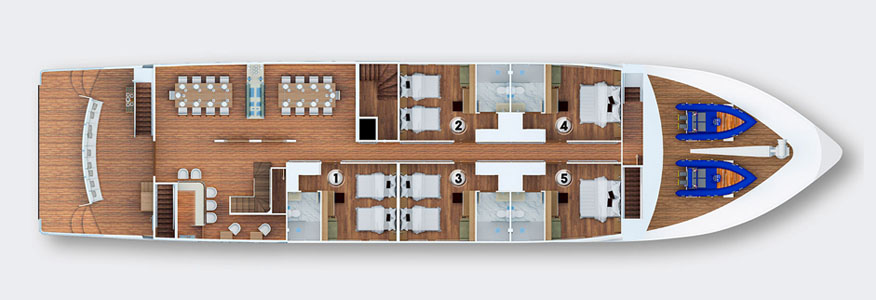
Upper Deck
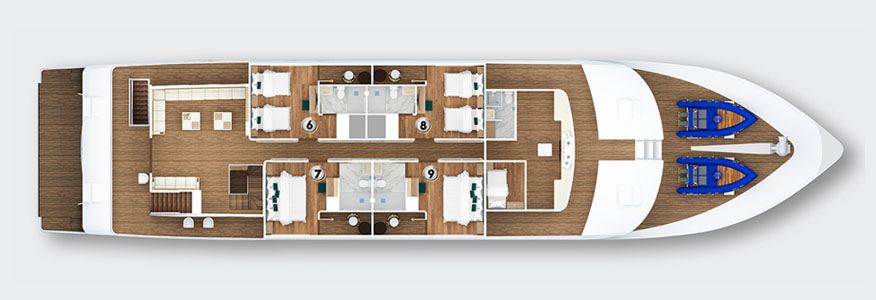
Sun Deck

Specifications
| CLASIFICATIONS: |
|
| CABINS: |
|
| CREW: |
|
| SPECIAL AMENITIES: |
|
| CAPACITY: |
|
| CABIN SIZES: |
|
| BATH SIZE: |
|
| BALCONY SIZE: |
|
| HULL TYPE: |
|
| LENGTH: |
|
| SPEED: |
|
| BED SIZES: |
|
| VOLTAGE AND PLUGS: |
|
| YEAR BUILT: |
|
| NEXT MAINTENANCE: |
|


